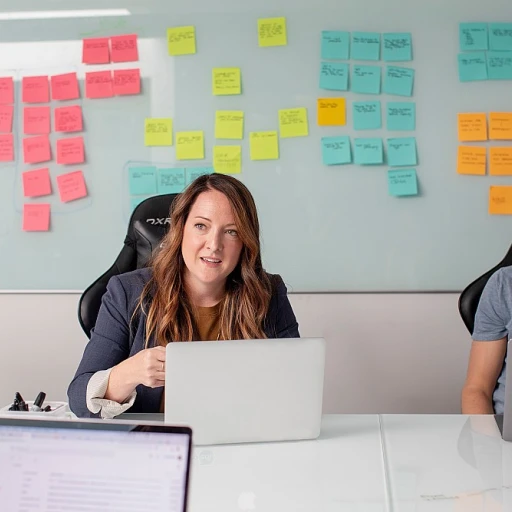
Understanding the Importance of Readiness in Management
The Crucial Role of Readiness in Management
Understanding the concept of readiness is essential for achieving success in management. At its core, readiness in management refers to how prepared an organization, team, or individual is to navigate and implement change effectively. Whether we're discussing the education sector's focus on school readiness for children, or businesses prioritizing workforce readiness, the underlying strategy revolves around being equipped to handle upcoming challenges. In an ever-changing environment, readiness equips leaders with the foresight to anticipate shifts and adjusts strategies accordingly. Incorporating readiness into management involves developing plans that reflect an organization's health, ability to adapt, and willingness to embrace changes. This preparedness is not just about collecting data but entails cultivating certain skills and fostering a supportive community. For educational institutions like middle schools and colleges, readiness can mean ensuring students are prepared for future academic and career opportunities. In contrast, organizations deal with readiness more as an organizational change model, where strategies are tailored to support transitions and implementations. It's crucial to highlight the significance of organizational readiness in change management, particularly in sectors where mental health services and technical assistance play vital roles. Understanding this significance aids in creating evidence-based and adaptable context-aware strategies. To delve deeper into crafting a comprehensive strategy, organizations can benefit from reviewing strategic frameworks. For instance, exploring a comprehensive scorecard template can offer insights into evaluating and enhancing readiness strategies effectively. This resource demonstrates the blend of strategic planning with readiness assessments ensuring that both short-term and long-term objectives align seamlessly. In summary, readiness isn't just a standalone goal; it's deeply interwoven with the broader objectives of any entity striving for excellence in the face of unforeseen challenges. The journey towards safeguarding readiness starts with a mindset shift and is supported by robust strategies.Key Elements of High-Quality Readiness Strategies
Essential Components for Readiness
Creating a successful readiness strategy hinges on a blend of key elements that guide the organization towards achieving its goals. Understanding the foundational components and how they serve the broader purpose is crucial for crafting high-quality strategies.- Data-Driven Approach: Integrating data into your readiness assessment process is vital. Utilizing data collection systems helps in evaluating organizational readiness and refining strategies based on evidence-based practices. By leveraging data, organizations can pinpoint areas needing improvement and track progress effectively.
- Organizational Model Alignment: The strategy must align with the existing organizational change model. This ensures a seamless integration across all levels, from workforce readiness to implementing kindergarten readiness programs. Alignment minimizes resistance and supports a smoother transition during changes.
- Comprehensive Implementation Process: A robust implementation process is key. This includes formulating an action plan that delineates distinct phases, responsibilities, and timelines. Effective implementation relies heavily on the clarity and precision of the action plan.
- Community and Stakeholder Engagement: Engaging the community, including teams, students, and stakeholders, reinforces the strategy. By fostering an inclusive environment, organizations can gather beneficial insights, support, and build a coalition for change.
- Supportive Learning Environment: Creating opportunities for learning and development is crucial. From early childhood education to middle school and college, establishing an environment where continuous learning is encouraged helps in strengthening both individual and team skills.
- Change Management Techniques: Readiness strategies should incorporate proven change management techniques. This includes addressing mental health support for employees and offering technical assistance to ease the transition. Techniques that focus on the human aspect of change are often more successful.
- Evaluation and Adjustment: Regular readiness assessments and evaluations are essential. Continuously revisiting and adjusting strategies ensures they remain relevant amidst changing circumstances. This adaptability is critical for maintaining high-quality readiness plans and achieving intended outcomes.
Developing a Culture of Preparedness
Fostering an Environment of Readiness
Developing a culture of preparedness is pivotal for facilitating seamless organizational readiness. It involves embedding the readiness mindset across the team, where every member is proactively engaged in anticipating and adapting to change.
Implementing effective readiness strategies requires a commitment to continuous learning and the enhancement of skills among employees. The educational foundation laid out during school readiness plays a vital role in shaping future workforce readiness. As children progress from kindergarten readiness to college career preparedness, they're equipped with critical skills necessary for the workforce.
To nurture a readiness culture, organizations should focus on several key areas, such as:
- Inclusive Community Building: Cultivating a sense of belonging where every team member feels valued is essential. It supports mental health and promotes collaboration, making the team more adaptable to changes.
- Data-Driven Strategies: Leveraging data collection and readiness assessment tools to guide actions and improve processes. This evidence-based approach ensures strategies are grounded in real insights.
- Education and Continuous Improvement: Encourage continuous learning opportunities to keep skills sharp and relevant. This may include workshops, e-learning platforms, and technical assistance to enhance the implementation process.
- Organizational Change Models: Use change management frameworks to steer organizational change. They help in forming an efficient implementation process and creating an action plan that prioritizes key objectives.
By intertwining strategies with the organizational culture, teams can not only prepare for the impending change but also thrive through it, ensuring sustainable success in the long run.
Tools and Techniques for Readiness Assessment
Utilizing Effective Tools for Readiness Assessment
In the journey towards crafting effective readiness strategies, the right tools and techniques play a pivotal role. These tools not only help in assessing the current state of readiness but also in identifying areas that require improvement. Whether it's for organizational change, school readiness, or workforce readiness, the process of readiness assessment is crucial.
One of the primary tools in readiness assessment is data collection. Gathering data from various sources allows management to understand the existing gaps in skills, resources, and processes. This data-driven approach supports the development of an evidence-based action plan, ensuring that strategies are tailored to meet specific needs.
Implementing Assessment Models
Assessment models are essential in evaluating readiness levels. These models provide a structured framework for analyzing different aspects of readiness, such as mental health, career readiness, and organizational readiness. For instance, in educational settings, assessing school readiness involves evaluating early childhood education programs and kindergarten readiness. Similarly, in a corporate environment, assessing workforce readiness might focus on the skills and competencies required for change management.
Moreover, readiness assessment models should be adaptable to various contexts, whether it's a middle school preparing students for college or a company undergoing organizational change. The flexibility of these models ensures that they remain relevant and effective across different scenarios.
Engaging the Community and Stakeholders
Engagement with the community and stakeholders is another critical aspect of readiness assessment. Involving team members, students, and even parents in the assessment process fosters a sense of ownership and collaboration. This collective approach not only enriches the data collected but also enhances the implementation process of readiness strategies.
Furthermore, technical assistance can be sought to support the readiness assessment process. Experts in the field can provide valuable insights and guidance, ensuring that the strategies developed are of high quality and aligned with the organizational goals.
In conclusion, the tools and techniques for readiness assessment are integral to the success of any readiness strategy. By leveraging data, implementing robust assessment models, and engaging the community, organizations can effectively prepare for change and achieve their desired outcomes.
Overcoming Challenges in Implementing Readiness Strategies
Addressing Common Obstacles in Readiness
In the journey towards developing robust readiness strategies, organizations often encounter various challenges. These hurdles can arise from several facets, ranging from organizational change resistance to insufficient data collection practices. By understanding these common obstacles, leaders can effectively formulate strategies to mitigate them and ensure successful implementation. One prevalent challenge is resistance to change among team members. Overcoming this requires a well-thought-out change management approach, where the focus lies on aligning the workforce readiness with organizational goals. Encouraging community support and fostering an environment where change is seen as an opportunity for growth will significantly aid in managing this challenge. Organizations may also struggle with a lack of quality school readiness and education programs that cater to all levels of the workforce, from early childhood through college and into career readiness. By investing in comprehensive learning and development initiatives, companies can bridge these educational gaps. Building partnerships with educational institutions can further reinforce these efforts and equip employees with vital skills. Data collection and analysis are crucial components of any readiness assessment model, yet they present another typical obstacle. Without accurate data, it's challenging to measure the current state of readiness or to develop evidence-based strategies. Organizations should implement sophisticated data management tools and processes that facilitate continuous data tracking and analysis, thereby enhancing the readiness assessment process. Mental health and well-being are increasingly becoming focal points in readiness strategies. Ignoring these aspects could impede the effectiveness of readiness plans. Integrating health services and mental health support into the organizational framework ensures a balanced approach to readiness, catering to the holistic needs of the team. Lastly, the financial and logistical aspects of readiness strategies can be daunting. Allocating resources efficiently and securing buy-in from stakeholders are essential for successful implementation. Developing a clear action plan that outlines the steps, timelines, and responsibilities will make the implementation process smoother and more manageable. By proactively addressing these challenges, organizations can optimize their readiness strategies and foster a culture of continuous improvement and preparedness. This strategic approach not only benefits the organization but also positively impacts the broader community, from students to professionals, ensuring a future-ready workforce.Case Studies: Successful Readiness Strategies in Action
Case Studies of Effective Readiness Strategies
Implementing readiness strategies effectively can be a game-changer in both educational and organizational settings. Let's explore some real-world examples where readiness initiatives have yielded positive outcomes, highlighting the strategies, tools, and techniques that drove success.
Transitioning to Workforce Readiness in Education
In schools, readiness programs are crucial for preparing students effectively for the next stages of their education and careers. For example, a well-known middle school implemented a comprehensive workforce readiness strategy, involving community partnerships and technical assistance to offer students an experiential learning approach. This allowed them to acquire essential skills and knowledge crucial for their future careers.
Navigating Organizational Change with Readiness Assessments
Organizational change often poses significant challenges. However, businesses that conduct thorough readiness assessments can tailor their strategies to manage change smoothly. For instance, a large organization managed to leverage data collection and analysis to foster an organizational culture adaptable to change. An action plan was developed, focusing on mental health support and career development, to ensure employees were equipped to handle transformation initiatives.
Enhancing College Career Readiness
Colleges also serve as vital grounds for cultivating career readiness among students. A specific college employed a readiness model aimed at equipping children and young adults with requisite skills before stepping into their desired career paths. The implementation process involved close collaboration with local businesses, providing students with industry-relevant experiences that enhanced their educational journey.
Early Childhood and School Readiness Programs
Focused on early childhood, some preschools have successfully integrated school readiness programs that address various domains like social-emotional skills and cognitive learning. By incorporating evidence-based practices, they ensure children are not only prepared academically for kindergarten but are also resilient to adapt to new learning environments.
These successful readiness strategies underline the importance of cultivating a proactive and supportive environment, be it in schools or organizations. Adoption of high-quality strategies tailored to the unique challenges of each setting can ensure seamless transitions and preparedness for future demands.












